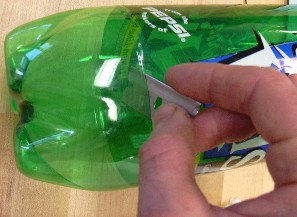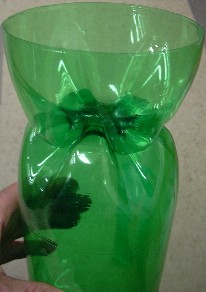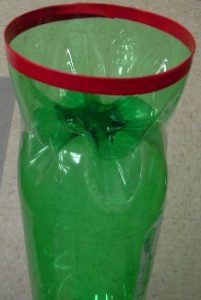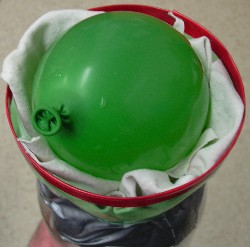"Be careful and proceed at your own risk"--Slater, the ScienceToyMaker

In the early days of 2-liter bottle water rockets I brought in my first launcher to show to my ninth grade technology classes. To make a long story short, before I could stop him a student--thinking I had looked away for a moment--put an apple on top of a bottle and quickly launched it. My first reaction was anger (the apple would have injured someone if it had landed on them). But I was also astonished at how high the apple went--almost out of sight.
Video tapes of soda bottle water rocket launches show that the water is pushed out within 4 or 5 meters of the ground. From then on the bottle has very little density: not much weight for the amount of volume it takes up. Because of the relatively low density, air resistance slows down the empty bottle very quickly. To see an extreme example of this try hurling or pounding an inflated balloon as hard as you can. No matter how fast it starts out, its momentum is completely gone within a meter.
By contrast, an apple (or a water balloon) weighs more than an empty bottle for a given amount of volume. So, while there is still air resistance, momentum carries it much higher. That's why bullets for guns use lead--much denser even than water--despite the toxicity of lead.
For the highest launches, match the size of the water balloon to the thrust of the rocket. In my experience, water balloons about the size of a small apple go the highest. Bigger water balloons are easier to see and make a satisfying splash when they land.
I offer water balloons as the least dangerous thing to send up. Launching a stone with a water rocket could easily kill someone if it landed on them, and whoever did it should be prosecuted to the fullest extent of the law just as surely a person who fatally shoots someone with a gun. That is not to say that launching water balloons instead is "safe." Even a water balloon really hurts if you try to catch it. Launching water balloons requires a big, empty field or lake to aim the launch into. Young children should be under roof or absent such events.
I got some feedback about the dangers of launching water balloons from Shawn Suttonm of Nebraska, which I reprint verbatim:
I am making water rockets with my boys and came across your page, it is the best I have found and now understand the cable tie trigger...thank you for the good pictures. I have a comment about the water balloons. A couple of years ago while launching water balloons with a water balloon launcher we accidentally had one of the small balloons, about the size of a baseball, hit a Dodge Durango hood right where it bends down to meet the grill. The launch angle was fairly high as we only wanted about 100 feet of distance and when the balloon hit it actually dented the hood at this bend point. The dent was the same size as the balloon. I do not know how high the balloon went or the height yours go. This was in the summer and the hood was probably warm but the force of the falling balloon was incredible. I thought I would share this expensive lesson with you.
Bottom line: be careful and proceed at your own risk.
How to Make a Water Balloon Launching Bottle
Make a special launching bottle by first cutting off the bottom of a bottle. I start the cut with a razor blade, then finish with scissors.

Fit it to another bottle (whole). The lobes interlock nicely.

Tape the top edge to make it less sharp. I used red electrical tape. I used 2" (50mm) wide clear packaging tape to hold the bottles together. It does not show up in the picture below. Everything must be dry when you apply the tape--then it's ok to get wet later.

I find that water balloons go the highest if I fill the 2-liter bottle only 1/3 of the way up with water.
Here is a water balloon packed and ready for launch. I put a rag or something below the balloon because I'm afraid the lobes will break the balloon at launch, though I have never experimented to see if it is really necessary.
